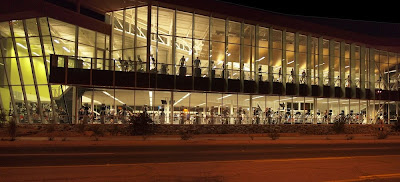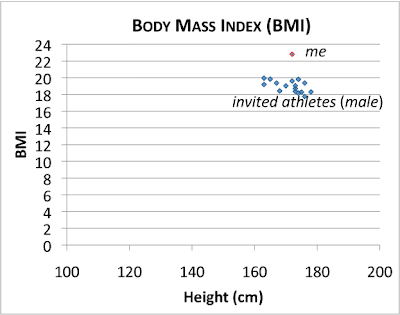
 In this increasingly homogenized world, minority styles are at a premium. For example, it's really difficult to find good choppers to loop against. Therefore this winter break, I was grateful for the opportunity to hit with Li Jun (李君) at the Pacific club while visiting Shenzhen.
She is a high-level chopper with Friendship 802 short pips with thin sponge on the red side (backhand) and inverted on the black side (forehand). Having resided in Belgium for a while, she speaks English (some Flemish as well) and understands my Cantonese. (I don't speak Mandarin unfortunately.) She was also ladies singles champion while in Belgium.
In this increasingly homogenized world, minority styles are at a premium. For example, it's really difficult to find good choppers to loop against. Therefore this winter break, I was grateful for the opportunity to hit with Li Jun (李君) at the Pacific club while visiting Shenzhen.
She is a high-level chopper with Friendship 802 short pips with thin sponge on the red side (backhand) and inverted on the black side (forehand). Having resided in Belgium for a while, she speaks English (some Flemish as well) and understands my Cantonese. (I don't speak Mandarin unfortunately.) She was also ladies singles champion while in Belgium.
 The so-called Pacific club, is officially called the 友傳乒乓城. It is conveniently located near the Mix City (万象城) shopping area in Luo Hu (罗湖). However, people know it as the Pacific club because of the name of the building in which it resides.
It has excellent air-conditioning (necessary for humid and hot summers in Southern China) and a range of court sizes. The cost (aka table fee) for one of the larger individually barriered courts ranges from around 40 to 55 RMB an hour: actual price depending on peak/off-peak demand. Of course, a large court is needed for the chopping game. (For comparison, an individually barriered court at the Shenzhen Century South China Table Tennis Club (深圳市世纪南华乒乓球俱乐部) that I've blogged about previously costs from 20 to 38 RMB per hour.)
In addition to the table fee, one must pay the coaching fee. In the case of Li Jun, she charges 100 RMB per hour. A reasonable practice session would range from 90 minutes to 2.5 hours. One needs about 20 minutes to warm up. And then looping 4 or 5 baskets of balls will take up the rest of the 2 hours. You can do the math.
First, let's warm up the forehand.
(Direct link to the video here.)
The so-called Pacific club, is officially called the 友傳乒乓城. It is conveniently located near the Mix City (万象城) shopping area in Luo Hu (罗湖). However, people know it as the Pacific club because of the name of the building in which it resides.
It has excellent air-conditioning (necessary for humid and hot summers in Southern China) and a range of court sizes. The cost (aka table fee) for one of the larger individually barriered courts ranges from around 40 to 55 RMB an hour: actual price depending on peak/off-peak demand. Of course, a large court is needed for the chopping game. (For comparison, an individually barriered court at the Shenzhen Century South China Table Tennis Club (深圳市世纪南华乒乓球俱乐部) that I've blogged about previously costs from 20 to 38 RMB per hour.)
In addition to the table fee, one must pay the coaching fee. In the case of Li Jun, she charges 100 RMB per hour. A reasonable practice session would range from 90 minutes to 2.5 hours. One needs about 20 minutes to warm up. And then looping 4 or 5 baskets of balls will take up the rest of the 2 hours. You can do the math.
First, let's warm up the forehand.
(Direct link to the video here.)
And then, the reverse penhold backhand. (Direct link to the video here.)
As to be expected, you can probably see that my reverse penhold stroke has evolved a bit since my previous posts on the topic. (I may take the opportunity to blog about the technical changes involved next time.) Finally, we are ready to loop for an hour or two. First, looping on the forehand diagonal. (Direct link to the video here.)
Some background is appropriate at this point. I first learned to loop with short pips a long time ago. Despite switching to inverted at 1900 level, and progressing to a pretty solid 2100 rating years ago, the underpinnings of that loop with all its warts visible here (which currently hold me back) can be traced back to my first short pips experience. In short, I'm attempting to dump and re-tool my forehand loop. (Yes, I want to get rid of that same loop stroke that got me over 2000.) However, years of inappropriate reinforcement has meant that change has been particularly hard to come by without impacting power and spin in a major way. In particular, the ingrained timing and over-large backswing that I have developed has been a barrier to progress. It's gonna take a lot of effort to re-program my muscle memory. Looping against chop is an excellent way to overwrite that muscle memory. So on this visit, my plan was to play Li Jun every other day. This gives sufficient recovery time and also time to review the recorded video, and think about stroke changes. Since her chop is pretty high level, one must be able to loop a pretty strong ball even to put it on the table, and definitely a very strong ball if it's to challenge her chop. So there always pressure on the the looper. And under pressure, I tend to revert to old habits that die hard. Still, one must swim against the current sometimes... in order to spawn something better...












































